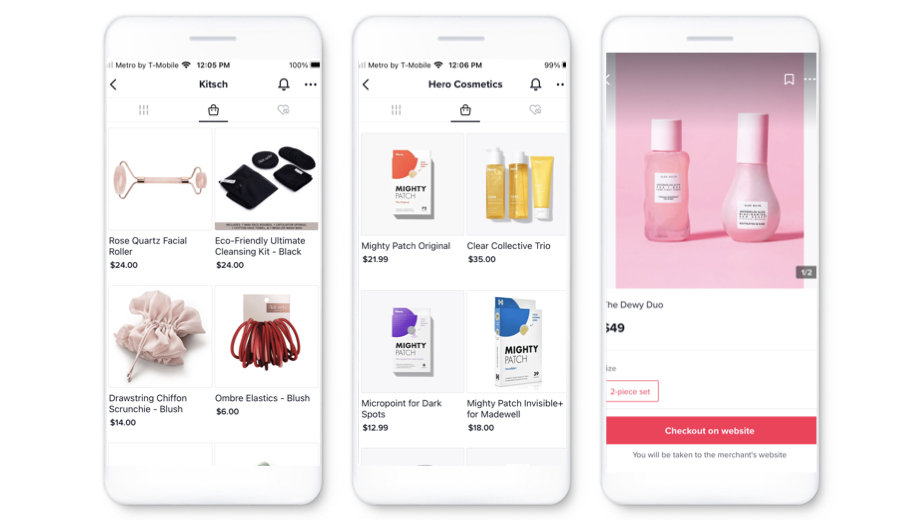On February 9, Glossy hosted a member-exclusive Executive Roundtable event at Alo Yoga Sanctuary & Studio on NYC’s 5th Avenue. Executives from fashion and beauty brands, retailers and agencies came together to discuss current marketing challenges and opportunities, with much talk turning to navigating social platforms and building brand communities.
Below are highlights from the three main topics of focus.
Content platform loyalty
Multiple executives mentioned that, as newer platforms like TikTok introduce pay-to-play models, customers may shift their focus to other platforms where the content still feels organic. They also discussed the challenge of creating entertaining, non-polished social content and the opportunity to leverage content created by customers.
“This notion of individuals being able to boost their own content through pay-to-play opens up some really interesting future strategies for brands that use influencers and UGC, ” said Angelic Vendette, CMO at Alo Yoga. “That’s great, because our community can have more visibility, if that’s something that they’re investing in. And it’s wonderful that there is an even playing field, although certain brands that have invested heavily might see a decline in views, which is generally the flip side of things.”
“Generations might start to stray further from TikTok, as we’ve seen with Instagram feeds where what’s being promoted isn’t exactly what people want to see anymore,” said an executive from a beauty conglomerate. “We’ve seen a lot of people, especially young people, start to pull away from Instagram. Will TikTok become the highlight reel that Instagram has become for a lot of young people?” For its part, her brand is currently focusing on videos featuring staff, which make the brand more approachable, she said.
“One challenge [of social platforms] is figuring out what the difference in KPIs is, from a brand perspective, to measure success,” said an executive from an indie beauty brand. “I’ve also been really curious about BeReal, tying it back to the need for realness and how a lot of Gen Z have this desire to pull back the curtain.” The brand is currently focusing on ASMR and unfiltered content on TikTok, which performs well for the brand, she said.
De-influencing
New trends on TikTok, like de-influencing, are proving to be causes of concern for small businesses, which rely on the platform for virality. However, the more viral a product becomes, the greater chance that it will be debunked, with influencers seeking out alternatives.
An executive speaking off the record said, “Small businesses and startups are nervous. If they’re gifting somebody, they don’t want them to get on TikTok and create a viral post talking badly about their mascara or cleanser. The small brands are asking how to navigate the trend.”
“I am less concerned for these smaller brands, because the types of products that I’ve seen people try to de-influence have been the cult, viral beauty and fashion buys that everyone talks about,” said an executive. “People think the brands that are safe to trash are the strong ones.”
Segmenting intimate communities online
Finally, brands like Alo Yoga are continuing to evolve in the web3 and digital spaces by speaking to segmented, micro-communities across these platforms.
“Each account has to resonate with so many different types of people,” said Vendette. “And you should have a different strategy for each platform. Second Life has a much older demographic, whereas Roblox is much younger, and we can talk to them differently.” In addidtion, she pointed out that Alo has multiple Discord channels catering to different users.
Text-based platforms like Twitter and Reddit are seeing renewed interest, with web3 communities proving instrumental in bolstering their popularity.
“There’s a large contingent of people who still do live on Twitter Spaces weekly, daily, ” said Vendette. “There’s a really supportive community there. Alo is also on Twitch for livestreams, and we’re on YouTube for video — both with on-demand and curated video content. You have to prioritize which channels are going to hit your audience.”
Clienteling-style communication is becoming more common through instant messaging platforms like WhatsApp, Slack and Discord. “My clients are using WhatsApp clienteling, actually, which is not anything new. And they’re also using Slack and Discord to create communities so they can have deeper conversations,” said an executive speaking off the record.
However, there are still some demographics that are falling out of brand community funnels.
“My clients are targeting the busy mom, age 35 and up,” said an executive from a fashion agency. “They’re trying to create communities, and there’s no response. That age demographic is not on Slack or Discord or Instagram, and they’re not really on TikTok. Some clients are using the platforms very successfully — but that’s dependent on their area of focus.”




